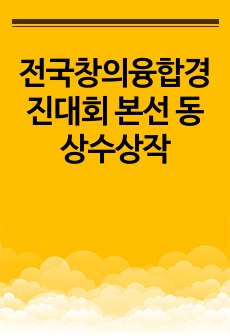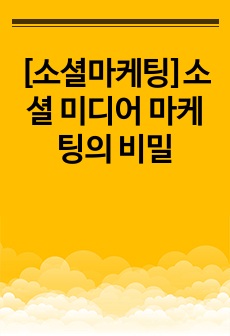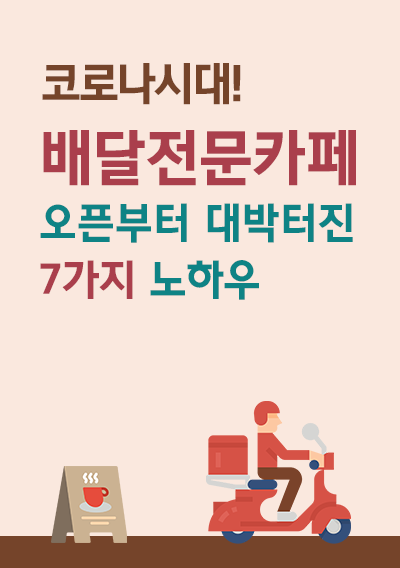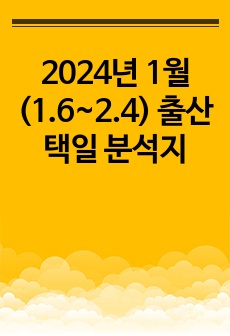[A+] 간호학과 조사방법론- 캡스톤 논문
안냐옹하다옹
다운로드
장바구니
소개글
간호학과 조사방법론- 캡스톤 논문<간호대학생의 팀 기반 심폐소생술 시뮬레이션 교육이 임상수행능력, 지식, 비판적 추론능력, 자신감에 미치는 영향>
참고문헌과 부록(설문지, 동의서, 측정도구) 등 자세히 작성하였습니다. 캡스톤 논문 작성에 도움이 되실 겁니다.
목차
1. 서론1) 연구의 필요성
2) 연구목적
3) 용어 정의
2. 문헌고찰
1) 시뮬레이션의 정의
2) 시뮬레이션기반 교육의 효과
3) 심폐응급간호에서 시뮬레이션기반 교육의 적용
4) 임상수행능력
5) 비판적 사고
3. 연구방법
1) 연구설계
2) 연구대상
3) 연구도구
4) 자료수집 방법
5) 자료분석방법
6) 연구의 윤리적 고려
4. 연구결과의 기대효과
5. 부록
본문내용
1. 연구의 필요성간호대학생은 간호교육을 통해 필요한 지식과 기술을 습득하여 사회가 요구하는 능력을 갖춘 전문직업인 간호사로 성장한다. 간호교육은 이론수업과 임상실습으로 구분되며, 이 중 임상실습은 이론수업에서 배운 내용을 실제 보건의료 현장에 적용하는 교육과정이다(이지혜, 전지은, 김수영, 2019).
최근 의료의 질 향상과 환자의 복잡성, 중증도 증가 등으로 간호사의 전문적인 역량확보가 매우 중요시되고 있다(이영희, 2002). 하지만 복잡한 질병에 대한 지식습득과 환자의 안전과 권리가 중요시 되면서 임상실습에서 간호대학생들이 수행할 수 있는 간호활동이 제한되고 있어 임상실습을 통한 지식과 기술 습득이 어려운 상황이다(조미혜, 권인수, 2007). 강의식 교육은 지식전달 면에서는 효과적인 교육방법이지만 복잡하고 다양한 문제가 발생하는 간호현장에서 실제적으로 필요한 간호업무능력을 향상시는 데는 한계가 있다(Ragsadale & Mueller, 2005). 따라서 강의식 교육을 통해 습득한 이론적 지식을 간호현장에서의 업무에 필요한 실무지식으로 전환시킬 수 있는 새로운 교육방법의 도입이 필요하게 되었다. 이를 위한 방안의 하나인 시뮬레이션 교육은 고도로 컴퓨터화된 시뮬레이터를 기반으로 간호학생들이 실무와 유사한 안정된 상황에서 반복적으로 학습할 수 있는 기회와 환경을 제공하며(양진주, 2008; Mahmoud, 2010), 응급상황에서의 시뮬레이션 교육은 환자나 타인을 위험에 빠트리지 않으면서 교육의 기회를 제공 하고(Long, 2005), 고위험 상황에 맞는 시뮬레이션 시나리오를 통해 임상에서 수행하기 어려운 경험에 대해 반복적으로 연습할 수 있도록 안전한 실습환경을 제공한다(한국의료시뮬레이션연구회, 2010)...
참고 자료
American Heart Association(2010). Advanced Cardiovascular Life Support(provider manual), 154American Heart Asociation(2006). BLS for Healthcare Provider.American Heart Association(2006). Advanced Cardiovascular Life Support.Alinier, G. Hunt, W. B, Gordon, R(2004). Determing the value of Simulation in Nurse Education: Study Design and Initial Results. Nurse Education in Practice, 4, 200-207.Barette, C, Myrick, F(1998). Job satisfaction in preceptorship and its effect on the clinical performance of the preceptee. Journal of Advanced Nursing, 27(2), 364-371.Bond, W. F, Spillane, L(2002). The Use of Simulation for Emergency Medicine Resident Assessment. Academic Emergency Medicine, 9(11), 1295-1298.Bond, W. F, Deitrick, L. M, Arnold, D. C, Kostenbader, M, Barr, G. C, Kimmel, S.R, Worrilow, C. C(2004). Using Simulation to Instruct Emergency Medicine Residents in Cognitive Forcing Strategies. Academic Medicine, 79(3), 438-446.Bearson, C. N, Wiker, K. M(2005). Human Patient Simulator: A New Face in Baccalaureate Nursing Education at Brigham Young University. Journal of Nursing Education, 44(9), 421-425.Brannam, J. D, White, A, Bezanson, J. L(2008). Simulator Effects on Cognitive Skills and Confidence Levels. Journal of Nursing Education, 47(11), 495-500.Baek Ji-yoon(2006). Effect of simulation-based education on nurses' ability to perform professional cardio resuscitation Master's thesis, Yonsei University, Seoul.
Bremner, M. N, Aduddell, K, Bennett, D. N, VanGeest, J. B(2006). The Use of Human Patient Simulators Best Practices with Novice Nursing Students. Nurse Educator, 31(4), 170-174.Blum, C. A, Borglund, S, Parcells, D(2010). High-fidelity nursing simulation: Impact on student self-confidence and clinical ompetence. International Journal of Nursing Education cholarship, 7(1).41. Chae Min jung(2015). Effects of cardiac arrest patient nursing simulation education on nursing students knowledge, confidence, critical thinking and clinical performance. A doctoral dissertation in nursing at Chonnam National University. 7.
Chae Min Jeong, Choi Soon Hee(2016). Effectiveness of Student Learning with a Simulation Program focusing on Cardiac Arrest in Knowledge, Self-confidence, Critical Thinking, and Clinical Performance Ability. 100-111, 447-458.“cardiopulmonaryresuseitation”, Korea Centers for Disease Control and Prevention National Health Information portal, last modified May 19, 2021, acessed May 30, 2021, https://health.kdca.go.kr/healthinfo/biz/health/gnrlzHealthInfo/gnrlzHealthInfo/gnrlzHealthInfoView.do Choi Hyang Ok(2006). A study on nurses' knowledge and performance in cardiopulmonary resuscitation. Master's thesis, graduate school at Yonsei University, Seoul. 60.Cooper, J. B, Taquetti, V. R(2004). A Brief history of the development of mannequin simulators for clinical education and training. Quality and Safety in Health, 13(Suppl 1), i11-i18.Corbridge, S, McLaughin, R, Tiffen, J, Wade, L, Templin, R, Corbridge, T. C(2008). Using Simulation to enhance Knowledge and confidence. Nurse Practitioner, 33(6), 12-13.Cho Mi Young(2010). An analysis of the status of domestic research on nursing practice education. Journal of Korean Nursing Education, 16(2), 239-248.Feltz, D. L(1988). Self-confidence and sports performance. Exercise and Sport Sciences Reviews. 16, 151-166.Facion, N. C, Facion, P. A, Sanchez, C. A(1994). Critical thinking disposition as ameasure of competent clinical judgement: The development of the california critical thinking disposition inventory. Journal Nursing Education, 33(8), 345-350. Hamilton R(2005). Nurses' knowledge and skill retention following cardiopulmonary resuscitation training: a review of the literature. Journal of Advanced Nursing, 51(3), 288-297.Holmberg M, Holmberg S, Herlitz J(2000). Effect of bystander car- diopulmonary resuscitation in out of hospital cardiac arrest patients in Sweden. Resuscitation. 47:59-70. Issenberg, S. B, Mcgaghie, W. C, Pertusa, E. R, Gordon, D. L, Scales, R. J(2006). Features and uses of high-fidelity medical simulation that lead to effective learning: a BEME systematic review. Medical Teacher. 27(1), 10-28.Jeffries,P.R(2005). Designing,Implementing, and Evaluating Simulations Used as Teaching Strategies in Nursing. Nursing Education Perspective, 26(2), 96-103.Jang Geum Sung, Choi Soon Hee, Choi Ja Yoon, Hong Mi Soon(2008). Clinical performance evaluation of nursing students using respiratory system standardized patients. Journal of the Korean Nursing Society, 38(1), 83-91.Kim Soo Young, Lee Ji Hae, Jeon Ji Eun(2019). Learning Experience of Undergraduate Nursing Students in Simulation: A Meta-synthesis and Meta-ethnography Study. 300-311Kwon In Soo, Cho Mi Hye(2007). A Study on the Clinical Practice Experiences on Nursing Activities of Nursing Students. The Journal of Korean academic society of nursing education, 13(2), 143-154.
Kang Hee Young, Kim Hae Ran, Choi Eun Young(2013). Nursing Student’s Experiences in Team Based Simulation Learning. 5-15 Kim Eun Jung, Kim Ji Young, Lee Kyeong Ryong, Lee Myung Hyun(2012). Nurses' cardiopulmonary resuscitation performance during the first 5 minutes in in-situ simulated cardiac arrest. Journal of Korean Academy of Nursing. 42(3), 361-368.
Kang Ji Soon, Oh Jae Woo, Lee Mi Yea(2010). The meaning of cardiopulmonary resuscitation experienceby nurses. Qualitative Research, 11, 134-145.Korea Association of Cardiopulmonary Resuscitation. Common cardiopulmonary resuscitation guideline development and distribution, Seoul: Korea Association of Cardiopulmonary Resuscitation. 2011, modified May 19, 2021, acessed. Available http://www.kacpr.org/popup/file/2011_guidelines.pdfKim Gi Yon, Kim Ki Kyong, Park So Mi, Shin Yoon Hee, Lim Young Mi, Choi Hyang Ok, Choi Ji Hea, Hur Hea Kung et al(2013). Development and applicability evaluation of an emergent care management simulation practicum for nursing students. The Journal of Korean Academic Society of Nursing Education. 19(2), 228-240.Kwon Mal Suk, Kwon Sang Min, Shin Seung Hwa(2013). Effects of a simulation-based training for advanced cardiovascular life support on the knowledge and competence for nursing students. Journal of the Korea Academia-Industrial Cooperation Society. 14(11), 5819-5826. Ko Jin Kyung, Park Jae Hyun, Yoo Hyo Bin. An effective method of teaching advanced cardiac life support (ACLS) skills in simulation-based training(2012). Korean Journal of Medical Education. 24(1), 7-14.Korea CPR Association, Korea CPR AssociationBasic resuscitation(KBLS), last modified May 13, 2021, acessed May 19, 2021,
http://www.kacpr.org/board/bbs_list.php?code=CPRbbs&category_idx=65&category1_code=1412125592&page_idx=1135” Kim Yoon Hee(2010). The effect of simulation-based cardiopulmonary emergency nursing education on the knowledge, clinical performance, and problem solving process of new nurses. Degree Thesis (Doctor) - Graduate School of Chonnam National University: Department of Nursing. 6-15.Kim In Soo(1996). Korean dictionary. Eunpyeong Institute of Language and Literature.Kwak Yoon Sil(2018). Relationship between knowledge, attitude, confidence in performance, and performance ability of nursing college students. 60.Ko Jong Hyun(2007). Simulation-based education is based on the ability of emergency services students to perform basic resuscitation. Korean Journal of Emergency Rescue, 11(3), 31-45Kim Chun Ja, Kim Yong Soon, Park Ji Won, Ahn Jung Ah, Yoo Moon Sook, Yoo Hye Ra, Chae Sun Mi(2012). The impact of critical thinking, self-efficacy, and leadership on clinical performance of nursing students. Journal of Korean Medical Education, 24(3), 223-231.Kwon In Soo(2002). Analysis of research papers on clinical practice training in nursing. Journal of the Korean Nursing Society, 32(5), 706-715.
Kim Sun Hwa(2015). Development and effectiveness of simulation-based healthcare-related infection management education programs for nursing students. Ph.D. thesis at Kyungpook National University, Daegu.Korea Institute of Nursing Education(2017). Self-assessment briefing session for nursing education certification evaluation in the first half of 2017.Kim Yoon Min, Kim Yoon Hee, Kang Seo Young(2010). Operation and evaluation of simulation-based intensive care education combined with Microsim®. Journal of Nursing Education in Korea, 16 (1), 24-32 .
Lee Young Hee(2002). (The) relationship between job satisfaction and burnout experience among preceptors in hospital. A dissertation on a master's degree in Korea, Yonsei University Graduate School of Education. Long, R. E. Using simulation to teach resuscitation: An important patient safety tool. Critical Care Nursing Clinics of North America, 17(1), 1-8.Lee Hyun Duk, Jung Sun Young(2018). Relationship between cardiopulmonary resuscitation (CPR) knowledge, professional attitude, and job performance: A descriptive analysis of medium-to small-sized hospital nurses, Unpublished Master’s Thesis, Ajou University, Gyeonggi.
Lisa S Ball(2009). A collaborative exercise between graduate and undergraduate nursing students using a computer-assisted simulator in a mock cardiac arrest. Nursing Education Perspectives. 30(1), 22-27.
Lo BM, Devine AS, Evans DP, Byars DV, Lamm OY, Lee RJ, et al(2011). Comparison of traditional versus high-fidelity simulation in the retention of ACLS knowledge. Resuscitation. 82(11), 1440-1443.Lim Kyung Soo, Hwang Seong Oh.(2011). Cardiopulmonary resuscitation and professional cardio. Gunja Publishing Company: Seoul.Lee Sun Ok, Lee Ju Hee, Eom Mi Ran(2007). The Journal of Korean Academic Society of Nursing Education 13(1), 90-94.Medley, C. F, Horne, C. Using simulation technology for undergraduate nursing education. Journal of Nursing Education, 31-34, 44.
Murray, C, Grant, M. J, Howarth, M. L, Leigh, J(2008). The Use of Simulation as a Teaching and Learning Approach to support PracticeLearning. Nurse Education in Practice, 5-8.
McCausland, L. L, Curran, C. C, Cataldi, P(2004). Use of Human Simluator for Undergraduate Nurse Education. International Journal of Nursing Education Scholarship, 1(1), 1-17.Moule, P, Wilford, A, Sales, R, Lockyer, L(2008). Student experiences and mentor views of the use of simulation for learning. Nurse Education Today, 28, 790-797.National Institute of Korean Language Standard Korean Dictionary (2000). https://stdict.korean.go.kr/Park So Mi, Hur Hea Kung(2012). Effects of simulation based education, for emergency care of patients with dyspnea, on knowledge and performance confidence of nursing students. The Journal of Korean Academic Society of Nursing Education. 18(1), 111-119. Pi Hye Young(2013). Effect of simulation-based practice program on ACLS study of paramedic students. The Korean Journal of Emergency Medical Services. 17(3), 139-147.Papa MJ(1989). Communicator competence and employee performance with new technology: A case study. Southem communication Joumal. 55(1), 87-101.Pacsi, A. L(2009). Human Simulators in Nursing Education. Journal of the New York State Nurses Association, 39(2), 8-11.Ragsdale, M. A, Mueller, J. Plan, do, study, act model to improve an orientation program. Journal of Nursing Care Quality, 20, 268-272.Ryoo Eon Na, Ha Eun Ho, Cho Jin Young(2013). Comparison of learning effects using high-fidelity and multi-mode simulation: an application of emergency care for a patient with cardiac arrest. Journal of Korean Academy of Nursing. 43(2), 185-93.Rodgers DL, Securro S Jr, Pauley RD(2009). The effect of high-fidelity simulation on educational outcomes in an advanced cardiovascular life support course. Simulation in Healthcare. (4), 200-206.Rystedt, H., Lindstrom, B(2001). Introducing simulation technologies in nurse education. Nurse Education Practice, 1, 134-141.Silvestri. L. A(2002). Saunders Q & A Review for NCLEX-RN. PHiladelphia: W.B. Saunders Company.Simulation(2009). In Merriam-Webster Online Dictionary Retrieved. http//www.merriam-webster.com/dictionary/simulationSsenberg, S. B, Mcgaghie, W. C, Pertusa, E. R, Gordon, D. L, Scales, R.J(2006). Features and uses of high-fidelity medical simulation thatlead to effective learning: a BEME systematic review. Medical Teacher, 27(1), 10-28.Turcato, N, Robertson, C, Covert, K(2008). Simulation-Based Education: What's in it for Nurse Anesthesia Educators?. AANA Journal. 76(4), 257-262.Yoon. J(2004). A study on the critical thinking disposition of nursing students - focusing on a school applying integrated nursing curriculum. Journal of Academy Nursing Administration. 14(2). 159-66.Yang, Jin Ju(2008). Development and Evaluation of a Simulation-based Education Course for Nursing Students. Journal of Adult Nursing, 20(4), 14-24, 548-560.Yoo So Young(2013). Development and effects of a simulation-based education program for newborn emergency care. Journal of Korean Academy of Nursing. 43(4), 468-477. Yee, B, Naik, V. N, Joo, H. S, Savoldelli, G. L., Chung, D. Y, Houston, P. L, Karatzoglou, B. J, Hamstra, S. J(2005). Nontechnical Skills in Anesthesia Crisis Management with Repeated Exposure to Simulation-based Education. Anesthesiology, 103(2), 241-248.Zhang, Z, Luk, W, Arther, D, Wong, T(2001). Nursing competencies: personal characteristics contributing to effective nursing performance. Journal of Advanced Nursing. 33(4), 467-474.













![[A+] 간호학과 조사방법론- 캡스톤 논문](/doc/cover/26607320/A%2B__%EA%B0%84%ED%98%B8%ED%95%99%EA%B3%BC_%EC%A1%B0%EC%82%AC%EB%B0%A9%EB%B2%95%EB%A1%A0-_%EC%BA%A1%EC%8A%A4%ED%86%A4_%EB%85%BC%EB%AC%B8.jpg)





